What Kind of Bugs Live at the Beach?

As you head to the water this summer, you might be wondering what kind of insects you are seeing along the shore, and you might have heard some tales of "sand flies" or other creepy crawlers. Let our expert exterminators on Long Island walk you through all of the different types of beach bugs you might run into.
What are Beach Bugs?
Most of the time when we refer to "beach bugs," we are actually talking about a couple of different types of insects that might be found near the water. If you are a resident of Long Island, you are probably familiar with these pests when you venture out to the ocean front.
What Bugs Live on the Beach?
The beaches of Long Island are home to a variety of bugs that thrive in the warm, sandy environment. Some of the most common beach bugs found by the ocean of Long Island are:
- Sand Fleas—small crustaceans that burrow into the sand and can bite beachgoers.
- Sand Flies—tiny biting insects that feed on blood and are most active at dawn and dusk.
- Beach Hoppers—shrimp-like creatures that scavenge through seaweed.
- Blood Worms—marine worms with sharp jaws, are found in the sand, though they are more of a nuisance when encountered while digging.
- Horse Flies—prevalent, especially in sunny areas, and can deliver painful bites.
These pests are all part of the coastal ecosystem and can occasionally disrupt a peaceful day at the beach.
What are Sand Fleas?
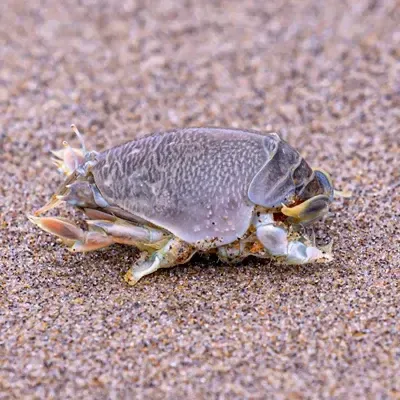
Sand fleas, also known as sand mites, are tiny little crustaceans that are found near the water along beaches all over the world. Despite their name, they are not actually fleas, but rather small crustaceans that burrow into the sand. These pests measure around 1/16th of an inch long and have a reddish-brown coloration, blending seamlessly with their sandy environment. Sand fleas are known for their impressive jumping ability, capable of leaping up to 7 inches in the air. While they can’t fly, their ability to jump allows them to navigate the sandy beach with ease. If you’ve ever walked along the beach and felt something suddenly jump on your leg, chances are it was a sand flea. These insects are known to bite, causing itching and small red welts, which can be uncomfortable and annoying for beachgoers.
How to Identify Sand Fleas
- Size: ~1/16th of an inch long.
- Color: Reddish-brown, blends with sand.
- Behavior: Jumps up to 7 inches, often felt jumping onto legs.
- Location: Found in damp sand near the surf zone.
Are Sand Fleas Dangerous?
When it comes to humans, sand fleas are more of a nuisance than anything else. These insects are known to bite humans, and they can be quite persistent when it comes to getting their way. The real worry is sand fleas latching onto your pets. Just like a normal flea infestation, think of sand fleas as causing the same amount of trouble, so make sure this pest does not hitch a ride back to your home.
What are Sandflies?
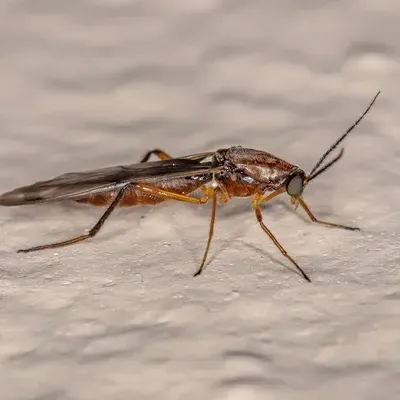
Sand flies, also known as no-see-ums, midges, or kelp flies, are tiny, biting insects found in sandy coastal areas. These flies are typically 1 to 3 millimeters long and have a distinct, hairy body with wings. Sand flies are most active at dawn and dusk, especially in moist, marshy areas near the beach. Only the female sand fly feeds on blood, which is necessary for egg development. Their bites can result in itchy, red welts that can be bothersome. In some regions, sand flies can also transmit diseases like leishmaniasis, making them more than just an annoyance. If you frequent sandy beaches, especially at twilight, sand flies may be an unwelcome presence.
How to Identify Sand Flies
- Size: 1-3 millimeters long.
- Color: Tiny, hairy body with wings.
- Behavior: Active at dawn and dusk; females bite for blood.
- Location: Coastal and marshy areas.
Are Sandflies Harmful to Humans?
Yes, sand flies are harmful. Their bites are painful and can cause red, itchy welts, often leading to secondary infections if scratched. Sand flies are active in the evenings and at night, resting during the day in tree cavities, hollow logs, and even inside homes.
They can transmit several diseases, including:
- Vesicular stomatitis virus
- Carrion's disease
- Sandfly fever
- Cutaneous leishmaniasis
- Visceral leishmaniasis
- Pappataci fever
Prevent bites by using insect repellent, wearing protective clothing, and avoiding peak activity times at dawn and dusk. If you suspect a sandfly infestation in or around your beach home, contact your local mosquito exterminators for prompt and efficient relief.
What are Beach Hoppers?
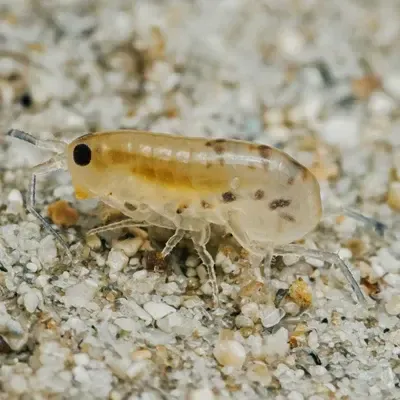
Beach hoppers, also known as amphipods, are small, shrimp-like crustaceans that can be found hopping around the sand and seaweed along coastal beaches. These pests typically range from a few millimeters to about a centimeter in size and are known for their ability to jump great distances relative to their size. Beach hoppers are scavengers, feeding on decaying plant and animal material found on the beach. While they are generally harmless to humans, their presence can be an annoyance, especially when they hop onto your belongings or skin. They are most active during the night and can be commonly found in areas with heavy seaweed deposits.
How to Identify Beach Hoppers
- Size: A few millimeters to about 1 centimeter.
- Color: Shrimp-like appearance, translucent or pale.
- Behavior: Jump around seaweed and debris, scavenging.
- Location: Near decaying seaweed piles on the beach.
Where do Beach Hoppers Live?
Beach hoppers live in sandy coastal areas, often around piles of decaying seaweed and driftwood near the high tide line. During the day, they burrow into the sand to escape the heat and dryness of summer, creating two distinctive holes—one for entering and one for exiting. These holes are a common sight on beaches and can be identified as their burrowing spots. Beach hoppers are more active at night, emerging to hop around and scavenge for food. Their unique burrowing behavior helps them survive the harsh daytime conditions of the beach.
What are Blood Worms?
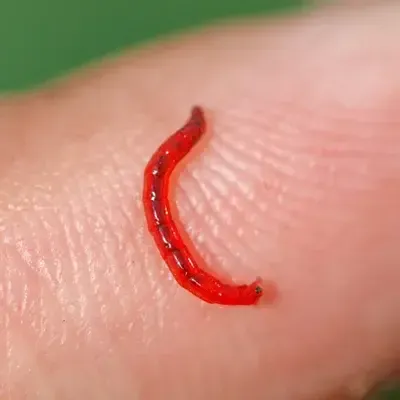
Blood worms are marine worms typically found in sandy or muddy coastal areas. They are easily recognizable by their reddish color, which comes from the high levels of hemoglobin in their blood. These worms can grow up to 14 inches long and are known for their sharp, venomous jaws. While blood worms are not a direct threat to humans unless handled, their bite can cause pain and irritation. They are often found burrowing in the sand near the water’s edge, where they prey on smaller aquatic organisms. Blood worms are commonly used as fishing bait, but encountering them while digging on the beach can be unpleasant due to their sharp bite.
How to Identify Blood Worms
- Size: Up to 14 inches long.
- Color: Red due to hemoglobin in their blood.
- Behavior: Burrow in sand or mud; have venomous jaws that can bite.
- Location: Intertidal zones, near water’s edge.
What Do Blood Worms Do?
Blood worms are marine worms that live beneath the sand on coastal beaches, where they play a vital role in the ecosystem. Through a process known as deposit-feeding, they ingest sand, digesting organic materials found between the grains, much like earthworms do in soil. This behavior helps clean the sand and recycle nutrients, contributing to a healthier beach environment.
Blood worms also burrow into the sand, leaving behind small holes that are often visible on the beach. Although they have sharp, venomous jaws used to capture prey, blood worms pose no harm to humans at the beach. In fact, they are beneficial to the environment and are commonly used as bait in fishing due to their high protein content.
What are Horse Flies?
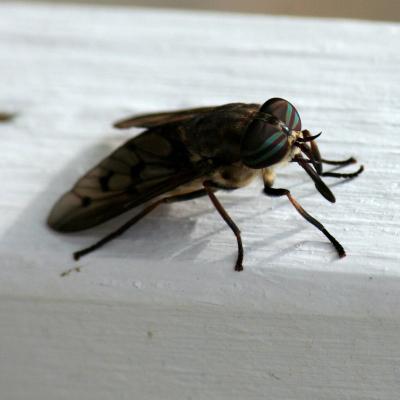
Horse flies are large, biting flies that are notorious for their painful bites. These pests are most active during the day, particularly in sunny, hot weather. Horse flies are known for their ability to fly long distances and for their powerful bite, which they use to feed on blood. Females require blood to lay eggs, while males typically feed on nectar. Their bites can be quite painful, leading to swelling, redness, and intense itching. Horse flies can occasionally transmit diseases to livestock and, in rare cases, to humans. If you’re spending time on a beach or in an area with lots of sun and open water, horse flies may be a bothersome presence, especially during the peak midday hours. They are most active during warm seasons and thrive on beaches backed by marshland or dune grass.
How to Identify Horse Flies
- Size: Large, robust body (up to 1 inch).
- Color: Black or brown with powerful wings.
- Behavior: Bites painfully; females feed on blood, males on nectar.
- Location: Sunny, open beach areas, especially midday.
Habits of a Horse Fly
- Feeding: Female horse flies require a blood meal to produce eggs. Unlike mosquitoes or sand flies, they don’t seek out hosts actively but instead sit and wait for one to pass by. Once they latch on, they will continue biting until they have consumed enough blood or are swatted away.
- Bites: Horse fly bites are extremely painful due to their sharp mouthparts and the anticoagulants they inject into the wound to keep the blood flowing.
- Activity: Horse flies are most active on warm, sunny days, especially in the late morning and afternoon.
- Flight: They are fast and aggressive fliers, often attacking anything that passes nearby.
- Habitat: Commonly found in areas with livestock or heavy human activity, such as beaches, pastures, and wooded areas.
- Impact: Their painful bites and aggressive behavior can make them a significant nuisance, especially for outdoor activities.
Professional Pest Control: Even For Beach Bugs!
No one wants to enjoy a day at the beach just to bring back pests that are hard to get rid of. If you are dealing with an infestation from any type of beach bug, look to A&C Pest Management for over A&C Pest Management years of expert pest control services. Our family-owned company offers same-day servicing as well as eco-friendly products, so you can feel safe that we are doing the job right the first time around!

